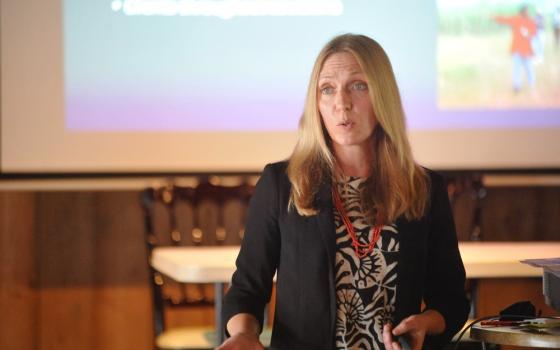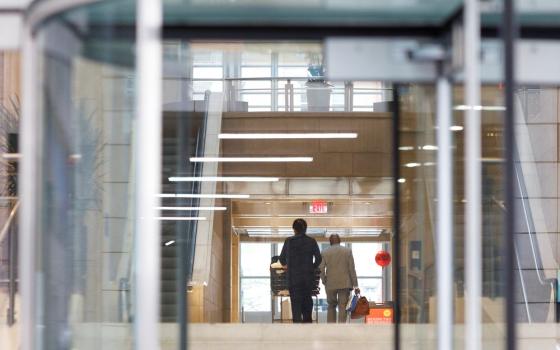
Updated March 25
San Salvador, El Salvador -- Thousands of Salvadorans and visitors from around the world who turned out March 24 in this capital city to mark the 30th anniversary of the death of Archbishop Oscar Romero heard Salvadoran President Mauricio Funes apologize for the government’s role in the assassination.
While long overdue in the estimation of some, the apology, delivered as Funes unveiled a portrait of Romero, signals a new era in Salvadoran politics.
“This marks a before and after in the history of El Salvador,” said Auxiliary Bishop Gregorio Rosa Chávez, according to news reports.
Funes, elected a year ago under the banner of the Farabundo Martí National Liberation Front, a left coalition of former guerrillas, asked forgiveness in the name of the country and said, “I know that it is a relief to society, that it is a balm for a country that is tired of violence and that seeks the reconciliation of spirit.”
While the state took a bold step, the church has yet to move Romero any further along the path of sainthood.
* * * * * * * * *
Sainthood for Romero? Not yet
San Salvador, El Salvador -- Thousands of Salvadorans and visitors from around the world walked in joyful procession through the streets of San Salvador on March 20 to mark the 30th anniversary of the death of Archbishop Oscar Romero. But those who came hoping for word of Romero's beatification or for real progress toward formal resolution by the Salvadoran state in his murder, this year's memorial held more questions than answers.
Today, March 24, marks the 30th anniversary of Romero's assassination while celebrating Mass in a hospital chapel.
The cause for Romero's canonization, begun 20 years ago and said to be picture perfect in meeting every criteria for holiness and orthodoxy, has hit a final bump in the road that could delay it indefinitely.
San Salvador's Archbishop José Luis Escobar Alas, just hours after celebrating a solemn Mass on the steps of the Metropolitan Cathedral, during which Romero was called both a martyr and a prophet, said: "With all respect we have asked and continue asking that the figure of Monseñor Romero not be a figure that is manipulated, politicized or used, but rather be a figure that is highly respected, precisely because of the process that is being carried out."
To many here, the archbishop's remarks amounted to another way of saying that in order to advance toward sainthood, the figure of Romero must somehow be separated from all controversy. The view constitutes a final criterion that highlights the complex debate over how Romero's life and death might be interpreted as a turning point for both the church and for the future of El Salvador.
Parallel to the question of Romero's canonization process has been the 20-year pursuit of legal responsibility for his murder and for the deaths of more than 75,000 Salvadoran citizens before and during the nation's bloody civil war. Hopes for any substantive truth and reconciliation process to begin to heal the wounds of the war depend on the government's openness to acknowledging the role of the army, state security forces and sponsored death squads in the majority of the killings and disappearances.
Such openness has been indicated by El Salvador's young President Mauricio Funes, who has taken up Romero's "option for the poor" as the keynote of his administration. However, a political stalemate over lifting a 1993 amnesty law that prevents prosecution for war crimes and human right abuses has stymied progress on this important national issue. Romero will be honored with a mural at the main airport and a commemorative stamp, but, 30 years after his murder, his case, like those of thousands of other victims of a massive state repression, remains unresolved.
The question of sainthood for Romero, unofficially proclaimed throughout Latin America and preemptively by the Anglican churches of England, Canada and Australia, has been under an ecclesiastical microscope since his death. At the core of both his holiness and much of the controversy is that Romero embodied the "the church of the poor." And as the chief pastor of the Salvadoran church, a "St. Romero" would carry that model, or ecclesiology, into the international spotlight at a time when models for pastoral effectiveness and Gospel fidelity are critical for the global church. In other words, if canonized, Romero will be not be just another holy person or model for piety. He will be a canonized archbishop. In that capacity, he will be held up as an exemplar for the episcopacy and for the church itself.
Romero lived the "church of the poor," a phrase first invoked by Pope John XXIII before Vatican II and later affirmed by the Latin American bishops' meetings in Medellín, Colombia (1968), and Puebla, Mexico (1979), and it is in this respect that Romero's role as a martyred archbishop becomes significant and controversial.
Fr. Dean Brackley, an American Jesuit who went to serve in El Salvador in 1990 after six Jesuit priests and two coworkers were murdered by the Salvadoran army on the campus of the University of Central America, addressed the implications of canonizing Romero: "One has to suspect that if Romero were not a bishop, he might have an easier road to canonization. Because not everyone in the Catholic hierarchy is comfortable with presenting him as a bishop to be imitated."
Romero modeled the church of the poor for Latin America, Brackley told NCR, but "the message is universally valid. The church will only be a bearer of credible hope for humanity if it stands with the poor, with all who are victims of sin, injustice and violence. If we walk with them, as Romero did, we will embody the good news that the world so longs for."
Tying Romero's sanctity as an archbishop to the church of the poor is a theme that Jesuit theologian Jon Sobrino has explored since 1980, the year Romero was killed. Sobrino, who served as a close advisor to Romero, escaped assassination in 1989 because he was out of the country when the Jesuits were killed at the university. He has been a tireless interpreter of Romero's embodiment of a renewed, justice-oriented church. He has also been under Vatican scrutiny for his writings on "liberation theology," which holds that human liberation and development are within God's plan for salvation history.
In an article published in 2009, Sobrino spoke of the resistance Medellín's church of the poor has faced over the years:
"Envisioning the church as 'poor and powerless' has never prospered much among us. … As Fr. José Comblin says: 'After Puebla there began the Church of Silence. The church began to have nothing to say.' Although the Aparecida conference [of Latin American bishops meeting with Pope Benedict XVI in Brazil in 2007] slowed down the decline a bit, the church has still not experienced that 'turning around of history' that Fr. Ignacio Ellacuría said was needed in order to heal a society that is gravely ill. The conclusion is that we need to return to being a church of the poor and to work hard for that. In El Salvador, since the death of Archbishop Romero, the erosion has been clear, as has been the need for ecclesiastical regeneration."
(The full text of Sobrino’s article, translated by Jesuit Fr. Joseph Owens, is available here.)
Romero's road to martyrdom was neither direct nor obvious. Trained and ordained in Rome in 1942, Romero was known as a conservative cleric when he served as secretary for the Salvadoran bishops preparing to attend the meeting in Medellín, and then as a bishop from 1970 until his appointment as archbishop of San Salvador in 1977. While he was very pastoral, always obedient to church teaching, Romero resisted the liberalization of attitude, dress, pastoral and liturgical style so evident in the life of the changing church. He was publicly opposed to any pastoral ministry that appeared to engage in political action.
But after the murder of Jesuit Fr. Rutilio Grande, Romero's friend and a devoted pastor who had championed the rights of campesinos in their struggle for just wages and land reform, Romero emerged as a strong voice for the poor. A shift in the historical alignment of the hierarchy with rich elites and the military was taking place throughout Latin America, and Romero's recovery of the church of the poor shaped his own role as pastor. The people embraced him and their faith inspired him. He once remarked, "With this people it is not hard to be a good shepherd."
Under Romero's leadership, the church in San Salvador became fully collegial at every level. His offices at the seminary and his Masses at the cathedral became centers of dialogue and reflection on the events of the day in the light of the scriptures and church documents. Romero wrote four pastoral letters to address the complex challenges facing the church in relationship to the government, to the popular organizations and political parties that rose to protest injustices and the violence of the security forces. His Sunday homilies were broadcast by radio throughout Central America (except when the station or its towers had been bombed). His letters and sermons were the fruit of constant consultation with his priests, religious and people.
Romero responded to the deteriorating social reality in El Salvador as he evolved in his role as archbishop. As teacher, preacher and pastor, he made the church visible to itself as the body of Christ. He moved constantly throughout the archdiocese, saying Mass, confirming young people, burying the dead and encouraging everyone. He listened to, prayed for and counseled the people who were undergoing suffering and oppression. To critics who said he was politicizing the church, Romero said often that there could be no "spiritual" walking with the poor without committing to social transformation on their behalf.
With the election of Pope John Paul II in 1979, whom Romero would meet twice, his struggle against an increasingly brutal repression in El Salvador was often characterized at the highest levels of the church as implied support for Marxism and violent revolution, even though he strongly criticized abuses by the left as well as by the right. By late 1979, with the U.S. beginning to intervene, the Vatican mischaracterizing his statements and the civil war rapidly approaching, Romero would play out his final months as archbishop by using his homilies to define his coming death as a paschal offering for the eventual resurrection of the Salvadoran church.
Saying his last Mass on March 24, 1980, in the chapel at the hospital where he lived, Romero had just read the Gospel passage from John 12:23-23: "The hour has come for the Son of Man to be glorified …Unless the grain of wheat falls to the ground and dies, it remains only a grain, but if it dies it bears much fruit." Moments later he was shot through the heart by a sniper.
The shocking nature of his death and the stunning implications of his example have made the question of canonization even more relevant for the universal church. In a global economy marked by what the bishops at Medellín, almost 40 years ago, called the "institutionalized violence" of poverty that remains the fate of billions, the question remains, does the church walk with the poor?
"That is what Romero did." said Brackley, "inspiring countless others to collaborate with him. This will invite persecution and misunderstanding, but that is the fifth mark of the true church. Romero sought not what was best for the institution as such, but what was best for the people. In the long run, that is what is best for the church, too. The institution that strives to save itself will lose itself. If it loses itself in loving service, it will save itself."
[Pat Marrin is editor of Celebration, NCR’s worship resource. He is in El Salvador covering the Romero anniversary events.]
Stories in this series
See also Pat Marrin's reflections: Holy Week 2010: Accompanying El Salvador |



